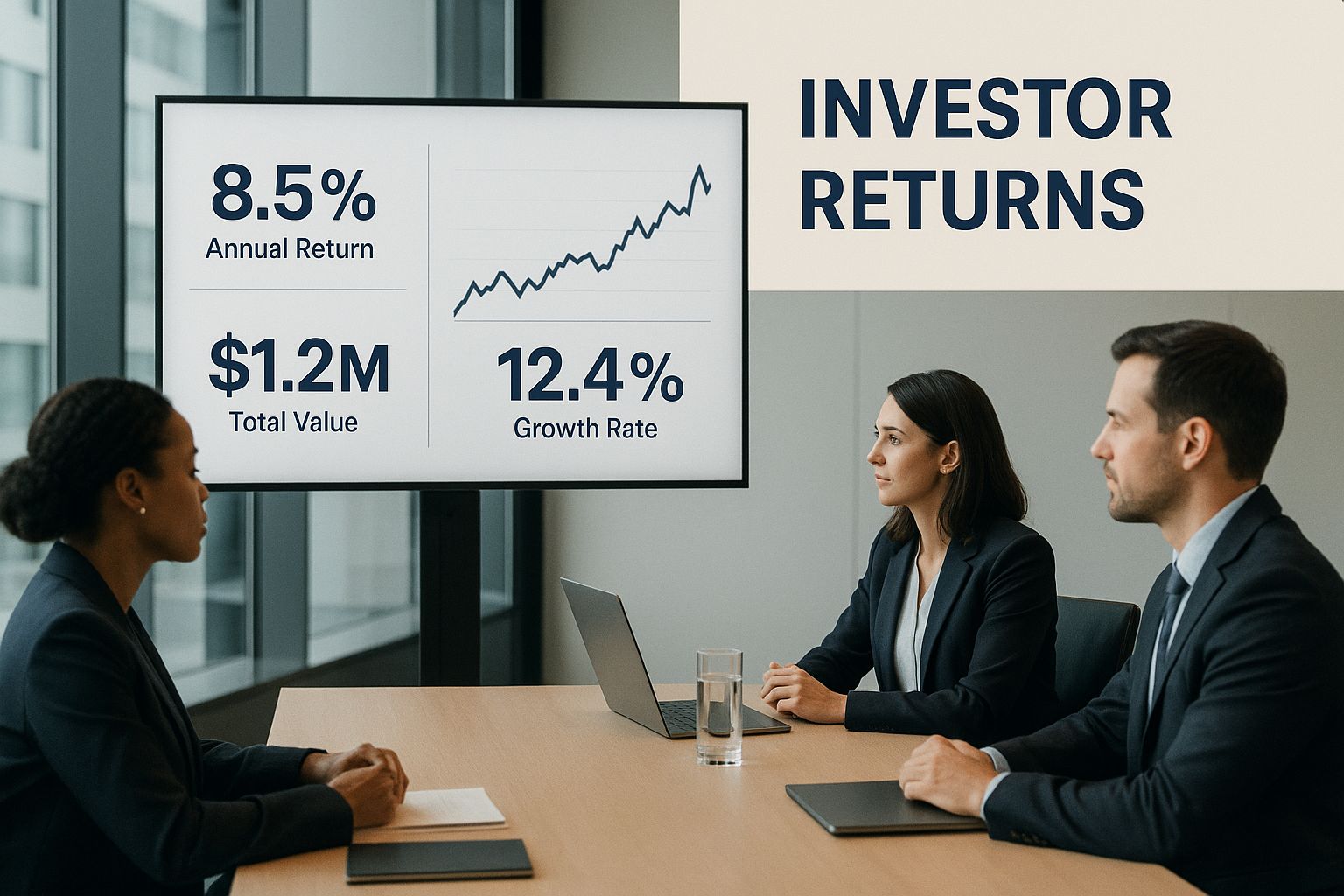A Guide to Mezzanine Debt Funds: Unlocking Higher Yields in Real Estate
- Ryan McDowell

- Sep 1
- 11 min read
Reading Time: 9 min | Good for: A, B, C
TL;DR: Key Takeaways on Mezzanine Debt Funds
What It Is: Mezzanine debt is a hybrid form of financing that sits between senior bank debt and owner's equity in a real estate project's capital stack.
How It Generates Returns: Investors earn returns through a dual-stream approach: consistent income from interest payments (typically 8-12%) and a share of the project's profits (an "equity kicker"), targeting total returns of 12-20%.
Why It Matters Now: As traditional banks tighten lending standards, a "capital gap" has widened, increasing demand from high-quality developers for mezzanine financing. This creates a lender's market with favorable terms for investors.
Who It's For: These funds are best suited for accredited investors and family offices seeking higher, risk-adjusted returns than senior debt, who are comfortable with the illiquidity of private real estate investments (typically 5-10 year terms).
Next Step: The key to success is partnering with an experienced fund manager who excels at underwriting, structuring protective terms, and vetting sponsors.
Market Why-Now: Unlocking Opportunity in the Capital Gap
For sophisticated investors, family offices, and anyone looking to access private real estate, understanding mezzanine debt is a game-changer in today's market. Why? Because traditional lenders like banks are getting more cautious. They're often only willing to finance 60-70% of a project's total cost, leaving a significant funding gap that developers need to fill.
This is exactly where mezzanine debt funds come into play. They provide that critical piece of the puzzle—often 10-25% of the total project cost—that bridges the gap between what the bank will lend and what the developer puts in. By filling this void, these funds are the key that allows high-potential real estate projects to get off the ground.
The Growing Demand for Alternative Financing
The market is clearly shifting, and private credit solutions like mezzanine debt are becoming more essential. As banks continue to tighten their lending standards, the demand from high-quality real estate sponsors for this kind of capital just keeps growing. This isn't just a temporary blip; it's a fundamental change in how real estate gets financed.
Just look at the numbers. The global mezzanine finance market was valued at around $197.52 billion in 2024 and is expected to more than double, hitting an estimated $420.79 billion by 2034, according to recent market analysis. That's a strong compound annual growth rate (CAGR) of 7.88%, which tells you that both investors and borrowers are increasingly turning to this solution.
Market Signal Box: A Lender's Market* The Data: Tighter bank capital requirements are creating new opportunities for private debt funds through significant risk transfer (SRT) deals. SRT issuance has been growing at a 25% CAGR since 2017, with a record $30 billion expected in 2024 alone (as of May 2024).* Interpretation: Banks are increasingly looking to offload risk, making them more reliant on partners like private credit funds.* Investor Take: For investors in mezzanine debt funds, this creates a lender's market. You can command better terms, stronger protections, and get access to top-tier projects led by proven sponsors. It’s a strategic moment to capture attractive, risk-adjusted returns.
Understanding this landscape is the first step to seeing how these specialized funds really work. If you're ready to go a level deeper, our guide to mezzanine debt funds for sophisticated investors breaks down exactly how to structure these investments.
Finding Where Mezzanine Debt Fits in the Capital Stack
To really get why mezzanine debt is such a smart play, you need to picture where it sits in a project’s financial structure. Every real estate deal is funded by different layers of money, known as the capital stack. The best way to think about it is like a skyscraper, where each floor is a different type of investment, each with its own level of risk and potential reward.
The order of these floors is everything. It dictates who gets paid first if the project is sold, refinanced, or hits a rough patch. This "payment priority" is the single most important detail in figuring out the risk and return for everyone involved.
Novice Lens: What is a Capital Stack?A capital stack is simply the organization of all the capital, from safest to riskiest, that goes into a real estate deal. Think of it as a ladder. The investors on the bottom rungs (senior debt) get paid first but earn the lowest returns. The investors on the top rungs (equity) get paid last but have the potential for the highest returns.
The Foundation: Senior Debt
At the very bottom of the skyscraper, forming its rock-solid foundation, is senior debt. This is your standard mortgage, usually coming from a bank or another traditional lender. Because the senior debt holders are first in line to get their money back, their investment is the safest one in the deal. But that safety comes with a trade-off: senior debt offers the lowest returns in the capital stack.
The Penthouse: Common Equity
Way up at the top of the skyscraper, you’ll find the common equity. This is the cash put in by the project sponsor or developer, along with their equity partners. These investors are the absolute last to get paid. Being "last-in, last-out" makes equity the riskiest piece of the puzzle. On the flip side, they also have the most to gain. They get to keep all the profits after every debt holder has been paid in full.
The Middle Floors: Mezzanine Debt
So, what’s between the secure foundation of senior debt and the high-flying penthouse of equity? The middle floors. And this is exactly where mezzanine debt lives.
Its position makes mezzanine debt a true hybrid. It sits below the senior loan, which means senior lenders have to be completely paid back before mezzanine lenders see a dime. But, it’s senior to the common equity, so mezzanine investors get their money before the equity investors see any profit.
This image shows how investor returns are structured within the different layers of the capital stack.
How Mezzanine Debt Funds Generate Returns

The Debt Component: Current Income from Interest Payments
The first and most predictable source of returns is the interest paid on the loan. This creates a consistent and reliable income stream for the fund and its investors. These interest payments usually come in a couple of flavors:
Cash-Pay Interest: The borrower pays interest in cash on a regular schedule, like monthly or quarterly. It’s the source of immediate, dependable income.
Payment-In-Kind (PIK) Interest: Instead of cash, PIK interest gets tacked onto the total loan balance. This deferred interest compounds over time and is paid back in full when the property is refinanced or sold, boosting the total return at the end.
The Equity Component: Upside from the Equity Kicker
The second, and often more powerful, return driver is the equity kicker. This is the feature that gives the mezzanine lender a piece of the project's future profits, almost like an equity partner. It's the "kicker" that turns a simple loan into a much more compelling investment.
Why It Matters for Novice Investors: Think of it this way: you lend a friend money to help them flip a house. They agree to pay you a fixed interest rate on the loan. But as part of the deal, they also give you 5% of the final profit when the house sells. The interest is your steady return, but that 5% profit share is your equity kicker—it's your reward for taking on a bit more risk to make the deal happen.
This equity participation can be structured in a few ways, such as warrants, profit participation, or conversion rights. The equity kicker is brilliant because it aligns everyone's interests. Both the mezzanine lender and the project sponsor are now motivated to maximize the property's value and ensure a highly profitable exit.
Deal Lens Example: A Value-Add Multifamily Project
Let’s walk through a simplified, real-world scenario to put it all together.
Imagine a sponsor is buying a $50 million multifamily property.
The bank provides a $30 million senior loan (60% LTV).
The sponsor contributes $10 million of their own equity (20%).
That leaves a $10 million gap in the funding.
A mezzanine debt fund steps in to provide that $10 million loan with these illustrative terms:
Interest Rate: 10% cash-pay interest per year.
Equity Kicker: 15% of the sponsor's profits when the property is sold.
Term: 5 years.
Here’s how the returns could play out:
Over the 5-year hold period, the fund collects $1 million in cash interest each year ($10M x 10%). That’s a total of $5 million in pure income. The sponsor executes their value-add plan, and after 5 years, they sell the property for $75 million.
First, they pay back the $30 million senior loan and the $10 million mezzanine loan principal. That leaves $35 million. After subtracting the sponsor's initial $10 million equity investment, the total profit on the deal is $25 million.
The mezzanine fund's equity kicker gives them 15% of that profit: $25 million x 15% = $3.75 million.
So, what’s the total return for the mezzanine fund?
Total Interest Received: $5,000,000
Equity Kicker Profit Share: $3,750,000
Total Return on $10M Investment: $8,750,000
This example highlights the power of the hybrid model. It delivered both steady income and a significant piece of the upside. While deal volumes change from year to year, investor demand for funds that can structure these deals remains high. As noted by sources like investmentbank.com, the U.S. continues to be the dominant force in fundraising for these types of strategies.
Understanding Key Risks and Their Mitigation

Risk: Subordination * Mezzanine debt is "subordinated," meaning it gets paid back only after the senior lender is made whole. If a forced sale doesn't generate enough cash, your investment could be at risk. * Mitigation: Ironclad Agreements & Due Diligence * Experienced managers perform conservative underwriting, stress-testing valuations against worst-case scenarios. They negotiate a critical legal document, the Intercreditor Agreement, which defines the mezzanine lender's rights, including the right to step in and cure defaults to prevent foreclosure.
Risk: Execution & Sponsor Risk * Your investment's success is directly tied to the sponsor's ability to execute their business plan. Construction delays, cost overruns, or slow lease-ups can threaten profitability. * Mitigation: Active Oversight & "Skin in the Game" * Managers don't just write a check and hope. They require sponsors to have significant cash equity in the deal, aligning interests. Funding is often released in stages based on hitting milestones, and constant communication allows managers to spot trouble early. For a closer look at this concept, see our guide to the types of investment risk in real estate.
Risk: Illiquidity & Market Risk * Mezzanine debt investments are illiquid; capital is typically locked in for the life of the fund (5-10 years). Over that time, a recession or interest rate spike could impact the project's exit value. * Mitigation: Clear Timelines & Cycle-Tested Experience * A good deal starts with a clear business plan and realistic timeline. Smart managers underwrite with multiple exit scenarios (sale, refinance) and have experience navigating downturns. The real test of a manager is their ability to protect capital when things get ugly.
Checklist: Questions to Ask a Sponsor
When you're ready to evaluate mezzanine debt funds, your due diligence process is everything. Use this checklist to tell the difference between a truly seasoned operator and a newcomer. A great sponsor won't just have an answer; they’ll back it up with data and a clear, disciplined philosophy.
Assessing the Manager’s Track Record & Specialization:
What is your team’s direct experience originating and managing mezzanine debt through different market cycles?
Can you detail your net IRR and equity multiple on prior mezzanine-focused funds?
How do you source your deals? (Look for proprietary networks and repeat business with trusted partners).
Evaluating Underwriting & Risk Management:
Walk me through your underwriting process for a recent deal, including how you stress-test assumptions.
How do you structure your intercreditor agreements to protect investor capital?
What is your protocol when a project underperforms? (Ask for their "workout" playbook).
The market is always changing. As of Q2 2024, a forward-thinking manager will be on top of shifts in private credit. You can get more insights on the private credit outlook at withintelligence.com. For a look at the broader landscape, explore these commercial real estate financing options for investors.
Finding the Right Partner for Your Portfolio
When managed with discipline, mezzanine debt funds can be a powerful tool for building long-term wealth. The strategy hits a sweet spot, capturing higher yields than traditional senior debt but with less risk than a pure equity play.
Aligning Strategy with Your Objectives
The key to success is finding a partner whose strategy clicks with your financial objectives. A top-tier manager brings more than just capital; they offer disciplined underwriting, deep market knowledge, and proactive asset management. Their job is to navigate the nitty-gritty of every transaction, from negotiating solid intercreditor agreements to making sure the business plan is executed flawlessly. That expertise is what turns a good project into a great investment.
Taking the Next Step
Mezzanine debt offers a solution to the capital gap in today’s real estate market, creating opportunities for informed investors. By partnering with an experienced team, you gain access to a carefully curated pipeline of deals that have been rigorously vetted for their risk-adjusted return potential.
At Stiltsville Capital, we focus on identifying these high-potential opportunities in growing markets. Our institutional-grade approach is built to deliver consistent performance for our partners. We’re firm believers that well-structured real assets are a resilient and prudent part of any long-term wealth strategy.
If you’re ready to learn more about how mezzanine debt can fit into your portfolio, we invite you to [schedule a confidential discussion with our team](https://www.stiltsvillecapital.com/contact).
FAQ: Your Questions Answered
Exploring mezzanine debt funds often brings up a few key questions. Here are clear, concise answers to the most common ones.
What Kind of Interest Rate Should I Expect?
Mezzanine debt is known for its attractive yields, typically landing somewhere between 10% and 20% annually. The final rate depends on the specifics of the deal. Your return usually comes in two parts: a cash-pay coupon (think 8-12%) that provides regular income, and a deferred piece like PIK interest or an equity kicker for extra upside.
How Long Is My Capital Tied Up?
An individual mezzanine loan is usually set to a 3 to 7-year term. When you invest in a fund, you should plan for your capital to be committed for the full fund life, which is generally around 7 to 10 years. You will often start seeing distributions before the fund fully winds down as individual loans get paid back.
Is Mezzanine Debt a Secured Investment?
This is a nuanced point. Mezzanine debt is not secured by a first mortgage on the property itself—that's for the senior lender. However, it is secured by a pledge of the ownership interests in the company that owns the property. This is a powerful protection that allows the mezzanine lender to foreclose on that ownership and take control of the project if a default happens.
Who Is the Right Type of Investor for These Funds?
Mezzanine debt funds are a great fit for accredited investors, family offices, and institutions who are looking for more yield than they can get from traditional fixed-income but don't want to take on the full risk of a direct equity play. The ideal investor has a long-term outlook and is comfortable with the illiquidity that comes with private market funds.
Information presented is for educational purposes only and does not constitute an offer to sell or a solicitation of an offer to buy securities. Any offering is made only through definitive offering documents (e.g., private placement memorandum, subscription agreement) and is available solely to investors who meet applicable suitability standards, including “Accredited Investor” status under Rule 501 of Regulation D. Investments in private real estate involve risk, including loss of capital, illiquidity, and no guarantee of distributions. Past performance is not indicative of future results.
At Stiltsville Capital, we connect accredited investors with institutional-quality real estate opportunities. If you're ready to see how mezzanine debt can fit into your portfolio, [schedule a confidential call with our team](https://www.stiltsvillecapital.com) to talk about your investment goals.





Comments